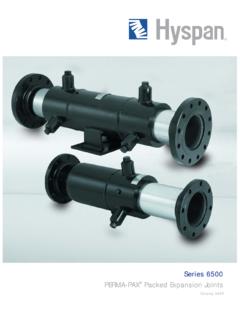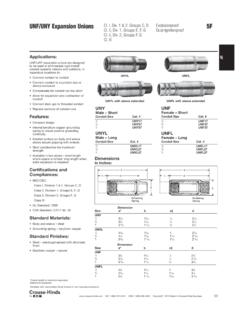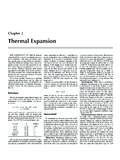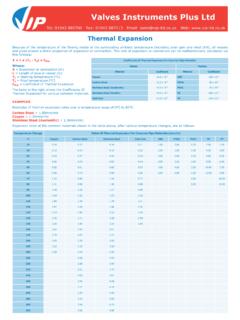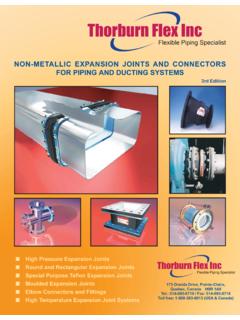Transcription of Axial Lateral Angular - Expansion Joints, Bellow, …
1 How a Bellows Works A bellows is a flexible seal. The convoluted portion of an Expansion joint is designed to flex when thermal movements occur in the piping system. The number of convolutions depends upon the amount of movement the bellows must accommodate or the force that must be used to accomplish this deflection. The convoluted element must be strong enough circumferentially to withstand the internal pressure of the system, yet responsive enough to flex. The longitudinal load (pressure thrust) must then be absorbed by some other type of device. These devices include pipe anchors, tie rods, hinges, or gimbal structures. Pressure thrust can be calculated by multiplying the effective area shown in the catalog by the working pressure. Axial Lateral Angular Pressure Thrust For the purpose of understanding pressure thrust, a single bellows designed for pure Axial motion can be modeled as hydraulic cylinder with a spring inside.
2 Force on equipment or adjacent piping anchors: "F" = (the effective area of the bellows) x (the working pressure) + (the spring rate of the bellows) x (the stroke of the bellows). The spring represents the Axial spring rate of the bellows. The hydraulic piston represents the effect of the pressure thrust which the Expansion joint can exert on the piping anchors or pressure thrust restraints (hinges, gimbals, tie rods) which may be part of the Expansion joint assembly. The area of the hydraulic cylinder would be the effective area of the bellows. For a 20", 150 psig catalog standard Expansion joint with 20 convolutions, the spring force for 1" of Axial stroke would be: (the Axial motion) x (the spring rate of the bellows) or 1 inch x 1521 Ibs.
3 / inch = 1521 pounds. The pressure thrust force would equal (the working pressure) x (the bellows effective area) or (150 Ibs. / inch^2) x (359 inch^2) = 53,850 pounds. The pressure thrust force is tExpansion joints designed for Lateral offset or Angular motion more complicated to model accurately. However, the effect of pressure thrust is the same. ypically much higher than the spring force. are Pressure Stresses The ability of a bellows to carry pressure is limited by hoop stress ns or S2 as defined in the standards of the Expansion Joint Manufacturers Association (EJMA). This is a stress that rucircumferentially around the bellows due to the pressure difference between the inside and the outside of the bellows. Hoop stress is what holds a bellows together like the hoops on a barrel.
4 This stress must be held to a code stress level. The customer should specify the code to be used. The bellow's ability to carry pressure is also limited by bulge stress or EJMA stress S4. This is a stress that runs longitudinal to the bellows centerline. More specifically, it is located in the bellows sidewall and it is a measure of the tendency of the convolutions to become less U-shaped and more spherical. For bellows that are not annealed after forming, S4 is allowed by EJMA to exceed the initial yield strength of the bellows material by a large margin because it is cold worked. If a bellows is annealed after forming, S4 must be severely limited because the bellows sidewall material is no longer cold worked. Accommodating a requirement for annealing will often result in the addition of reinforcing rings or a much heavier bellows material and more convolutions.
5 Our standard policy is to provide bellows in the as-formed condition to take advantage of the added performance that is imparted to the bellows through cold work. Senior Flexonics Pathway will accommodate annealing requirements on request. Squirm A bellows that is pressurized internally is similar in many ways to a column loaded in compression. At some loading, a long column will buckle. Similarly, an internally pressurized Expansion joint will eventually buckle or squirm at some internal pressure loading. It is the responsibility of the Expansion joint manufacturer to design the bellows to avoid squirm during operating conditions or pressure testing. Squirm can lead to catastrophic failure of a bellows. Our design equations treat squirm conservatively.
6 A hydrostatic test of the completed Expansion joint verifies stability. If hydrostatic testing is desired, it should be specified at the time of order placement. Cycle Life When a bellows deflects, the motion is absorbed by bending of the sidewalls of each convolution. The associated stress caused by this motion is the deflection stress or EJMA stress S6. This stress runs longitudinal to the bellows centerline. The maximum value of S6 is located in the sidewall of each convolution near the crest or root. Expansion joints are designed to operate with a value for S6 that far exceeds the yield strength of the bellows material. This means that most Expansion joints will take a permanent set at the rated Axial , Angular or Lateral motion. Expansion joint bellows are rarely designed to operate in the elastic stress range.
7 Therefore the bellows will eventually fatigue after a finite number of movement cycles. It is important to specify a realistic cycle life as a design consideration when ordering an Expansion joint. An overly conservative cycle life requirement can result in a bellows design that is so long and soft that it is subject to squirm failure. Multiple Ply Construction The necessary amount of metal to contain pressure can be achieved with a single ply of bellows material or multiple plies of material of reduced thickness. A bellows of multiple ply construction often has a lower spring rate than a single ply bellows for the same service. Thin material experiences less strain than a thick material for the same deflection. That means a multiple ply bellows may be shorter and it may have a higher cycle life than a single ply bellows for the same application.
8 Applications Single Expansion Joints AS have one bellows. Axial compression and extension, Lateral and Angular movement can be accommodated. These Expansion joints do not restrain the internal pressure thrust. The piping designer must provide the system with separate anchoring and guiding to resist the pressure thrust. Where small thermal movements are involved and proper anchoring and guiding is feasible, a single Expansion joint is the most economical installation. Tied Single AT Expansion Joints also have one bellows, except the overall length is restrained by tie rods designed to contain pressure thrust. A tied single is usually designed for Lateral offset so that the tie rods can remain fully engaged and loaded with the pressure thrust force.
9 A two tie rod design can accept Angular deflection in a single plane. Universal AU Expansion Joints consist of two bellows separated by a pipe spool. This configuration accommodates large Lateral movements, in addition to Axial compression and extension and Angular deflection. These Expansion joints have no restraints to resist pressure thrust and like the singles, the piping designer must provide separate anchoring to handle pressure thrust. Universal Tied, AUT Expansion Joints contain two bellows separated by a pipe spool and tie rods designed to contain the pressure thrust force. These Expansion joints are generally designed to accommodate Lateral movement only. A universal Expansion joint can be designed to have a very low Lateral spring force to minimize forces on adjacent equipment.
10 A two tie rod design can also accept Angular deflection in a single plane. The tie rods are usually at or near ambient temperatures and, therefore, do not expand and contract as a function of the temperature of the media within the pipe. As a result, the thermal Expansion of the length of pipe between the tie rod end plates is forced into the bellows as an Axial movement. The bellows design must accommodate this Axial thermal Expansion as well as the specified Lateral movement. Sometimes a universal Expansion joint has a very heavy center spool that can exert excessive weight on the bellows elements. To protect the bellows elements from excessive Lateral loads, a support system such as a slotted hinge can be installed across the individual bellows elements to support the dead weight of the center spool.
